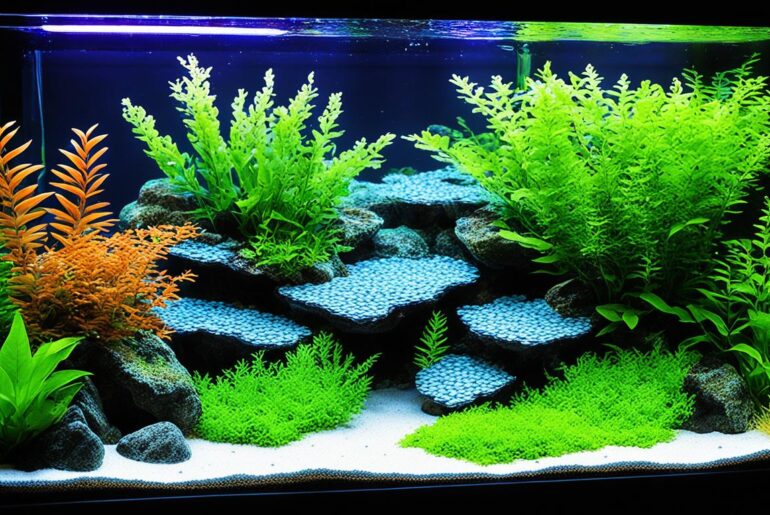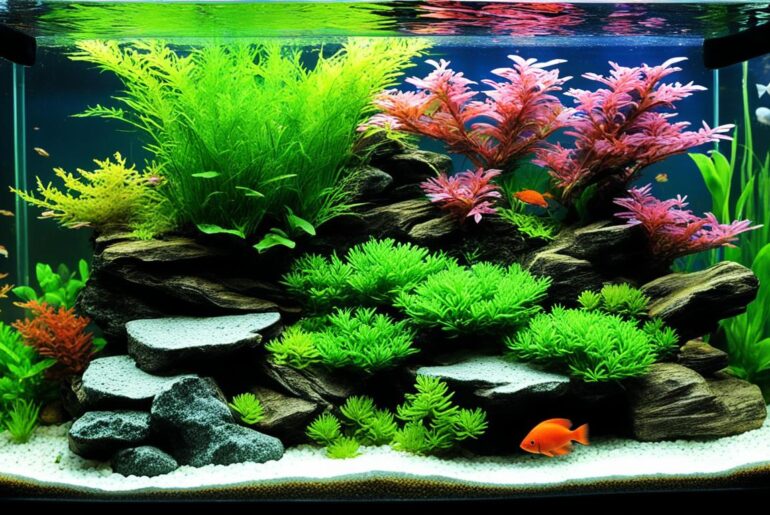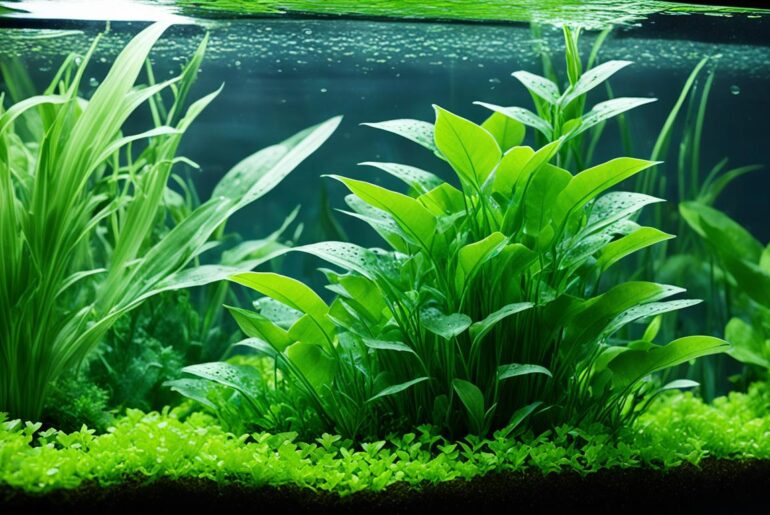When I decided to set up my first freshwater aquarium, I was filled with excitement and anticipation. I imagined vibrant fish swimming gracefully through crystal-clear water, creating a tranquil oasis in my home. Little did I know that achieving this dream would require much more than just adding water and fish to a tank.
I soon discovered the importance of properly cycling a new aquarium. It was a process that seemed overwhelming at first, but as I delved deeper into the world of aquarium keeping, I realized just how crucial it was to the well-being of the fish I planned to bring into this new habitat.
From the initial research to the hands-on experience, I dedicated myself to understanding the ins and outs of aquarium cycling. I embarked on a journey that allowed me to witness the incredible transformation of an empty tank into a thriving ecosystem. And now, I want to share my knowledge and experiences with you, in the hope that it will guide you towards successfully cycling your own freshwater aquarium.
Join me as we embark on this journey together, step by step, to learn the process of cycling a new freshwater aquarium. Together, we will explore the fascinating world of the aquarium nitrogen cycle, discover the benefits of fishless cycling, and understand the importance of creating a stable and healthy environment for our fish. Let’s dive in!
Key Takeaways:
- Cycling a new freshwater aquarium is crucial for the health and well-being of your fish.
- The aquarium nitrogen cycle is a natural process that converts harmful ammonia into less toxic substances.
- Fishless cycling is a humane and recommended method for beginner aquarists.
- Regularly monitoring water parameters and maintaining a cycled aquarium is essential for the long-term health of your fish.
- By following the steps outlined in this guide, you can successfully cycle your aquarium and create a thriving habitat for your fish.
Understanding Aquarium Cycling
Aquarium cycling plays a crucial role in establishing a safe and healthy environment for the fish in your new tank. It is a process that involves introducing nitrifying bacteria into the aquarium to regulate the nitrogen cycle. This natural cycle helps break down fish waste, particularly ammonia, which can be harmful to fish if left unchecked.
The nitrogen cycle in an aquarium consists of three main stages:
- Ammonia: Fish waste and decaying organic matter produce ammonia, which is toxic to fish.
- Nitrite: Nitrifying bacteria, specifically Nitrosomonas, convert ammonia into nitrite, another harmful substance for fish.
- Nitrate: Another group of nitrifying bacteria, Nitrobacter, further decompose nitrite into nitrate, a much less harmful form of nitrogen compound.
The presence of these nitrifying bacteria is vital in an aquarium as they help convert harmful ammonia and nitrite into a less toxic form, nitrate. This conversion process is known as the aquarium nitrogen cycle.
Here’s how the nitrogen cycle in an aquarium works:
| Stage | Description |
|---|---|
| 1. Ammonia buildup | Excess fish waste and organic matter produce ammonia, which can be toxic to fish. |
| 2. Growth of nitrifying bacteria | Nitrifying bacteria, including Nitrosomonas and Nitrobacter, establish colonies in the aquarium. They convert ammonia to nitrite, then nitrite to nitrate. |
| 3. Ammonia and nitrite reduction | The established bacteria continuously convert ammonia and nitrite to less harmful nitrate. |
| 4. Nitrate removal | Nitrate is removed through regular water changes and aquatic plant uptake. |
Understanding the nitrogen cycle and the role of nitrifying bacteria is crucial in maintaining a stable and healthy aquatic environment for your fish. By cycling your aquarium and promoting the growth of beneficial bacteria, you can prevent ammonia buildup and provide the best possible conditions for your aquatic pets.
Why is Aquarium Cycling Important?
Aquarium cycling is a crucial process that ensures the health and well-being of your fish. Let’s explore why it’s so important:
Preventing New Tank Syndrome
One of the key reasons for cycling your aquarium is to prevent a condition known as New Tank Syndrome. This syndrome occurs when a new aquarium is not properly cycled, leading to a buildup of harmful toxins.
If your tank is not cycled, ammonia and nitrite levels can rise to dangerous levels, putting your fish at risk. New fish introduced to an uncycled tank are particularly vulnerable to these toxins, which can cause stress, illness, and even death.
“New Tank Syndrome can have devastating effects on your fish. By cycling your aquarium, you significantly reduce the risk of this harmful condition, ensuring the long-term health and happiness of your aquatic pets.”
Preventing Ammonia Exposure
Ammonia exposure is another serious concern in newly set up aquariums. In an uncycled tank, ammonia levels can spike due to the breakdown of fish waste and uneaten food. This can lead to ammonia poisoning, which is highly toxic to fish.
By cycling your aquarium, you establish a colony of beneficial bacteria that help convert ammonia into less harmful substances. These bacteria play a vital role in maintaining a healthy nitrogen cycle, protecting your fish from the harmful effects of ammonia exposure.
Benefits of a Cycled Aquarium
Having a cycled aquarium offers numerous benefits for both you and your fish:
- Healthy Fish: A cycled aquarium reduces the risk of stress and illness in your fish, promoting their overall health and vitality.
- Water Stability: Cycling creates a stable aquatic environment with consistent water parameters, ensuring optimal conditions for your fish.
- Reduced Maintenance: A well-cycled aquarium requires less maintenance compared to an uncycled one. With a stable nitrogen cycle, you’ll have fewer water quality issues to address.
- Algae Control: A balanced and cycled aquarium helps prevent excessive algae growth, maintaining a visually appealing tank.

| Importance of Aquarium Cycling | New Tank Syndrome | Ammonia Exposure | Benefits of a Cycled Aquarium |
|---|---|---|---|
| Prevents harmful toxins from building up in the tank | Reduces the risk of stress, illness, and death in fish | Protects fish from ammonia poisoning | Promotes the overall health and vitality of fish |
| Establishes a stable aquatic environment | Creates consistent water parameters | Reduces maintenance requirements | Controls excessive algae growth |
How Long Does Aquarium Cycling Take?
The duration of aquarium cycling can vary depending on several factors. On average, it takes between four to eight weeks to complete the cycling process. However, this timeframe is not set in stone, and the actual time it takes to cycle an aquarium can be influenced by various factors.
The size of your tank is one of the key factors that can impact the duration of the cycling process. Larger tanks typically take longer to cycle compared to smaller ones. This is because a larger volume of water requires more time for the beneficial bacteria to establish and stabilize the nitrogen cycle.
Another factor that can influence the cycling time is the water’s pH and temperature. Ideally, the pH should be kept within the range of 6.5 to 7.5, and the temperature should be between 75 to 82 degrees Fahrenheit (24 to 28 degrees Celsius). Optimal pH and temperature conditions provide a favorable environment for the growth and activity of the nitrifying bacteria, expediting the cycling process.
During the cycling process, it is important to monitor the water parameters regularly. This includes testing the levels of ammonia, nitrite, and nitrate. Ammonia and nitrite levels should gradually increase and then decrease, while nitrate levels should begin to rise. This indicates that the nitrogen cycle is progressing correctly.
To monitor the water parameters, you will need an aquarium test kit. This kit will allow you to accurately measure the ammonia, nitrite, and nitrate levels in your tank. Regular monitoring ensures that any fluctuations or imbalances in the cycle can be addressed promptly.
Monitoring the water parameters during the cycling process is crucial to ensure that the cycle is progressing properly. By closely monitoring the levels of ammonia, nitrite, and nitrate, you can take necessary actions to maintain a healthy and stable aquarium environment.
To provide a visual representation of the factors influencing the cycling time, I have created the following table:
| Factors Influencing Cycling Time | Description |
|---|---|
| Tank Size | Larger tanks take longer to cycle due to the larger volume of water. |
| Water pH | A pH level within the ideal range of 6.5 to 7.5 promotes bacterial growth. |
| Water Temperature | An optimal temperature between 75 to 82 degrees Fahrenheit (24 to 28 degrees Celsius) accelerates the cycling process. |
By considering these factors and closely monitoring the water parameters, you can have a better understanding of how long it will take for your aquarium to cycle successfully.
Items Needed for Aquarium Cycling
Before cycling an aquarium, you will need certain items to ensure a successful cycle. These include:
- Fish Food: Fish food is an essential item for aquarium cycling as it helps produce ammonia in the tank. Ammonia is a vital component of the nitrogen cycle, and it is necessary to establish the biological filtration in the aquarium.
- Aquarium Test Kit: An aquarium test kit is crucial for monitoring water parameters during the cycling process. It helps you keep track of ammonia, nitrite, and nitrate levels, ensuring that the cycle progresses smoothly and the water conditions are optimal for the fish.
- Necessary Aquarium Components: It is essential to have all the necessary aquarium components, such as filters, pumps, and heaters, in place before starting the cycling process. These components are responsible for maintaining water circulation, filtration, and temperature control, creating a suitable habitat for the fish.
- Quality Water Filter: Using a quality water filter is vital to remove contaminants from tap water. Tap water often contains chemicals, such as chlorine and heavy metals, which can be harmful to fish. A water filter ensures that the water going into the tank is clean and safe for the fish.
By having these items ready, you can have a successful aquarium cycling experience and create a healthy environment for your fish.

Image: A high-quality water filter is an essential item for aquarium cycling.
Cycling an Aquarium without Fish
Fishless cycling is a popular and humane method of cycling an aquarium. It offers several advantages over traditional cycling methods that involve adding fish to the tank. By using the fishless cycling method, you can create a healthy environment for your fish while having better control over the cycling process.
In fishless cycling, a source of ammonia is introduced into the tank to stimulate the nitrogen cycle. One common way to achieve this is by adding fish food to the aquarium. As the fish food decomposes, it releases ammonia into the water, which serves as the source of nitrogen for the beneficial bacteria to establish and thrive.
Advantages of Fishless Cycling:
- Humane: Fishless cycling allows you to cycle your aquarium without subjecting fish to potentially harmful levels of ammonia and nitrite.
- Better Control: With fishless cycling, you have greater control over the cycling process. You can monitor ammonia and nitrite levels more easily and make necessary adjustments to promote a healthy cycle.
- No Stress on Fish: By cycling without fish, you eliminate the stress, disease risks, and potential casualties associated with traditional cycling methods.
- Faster Cycling: Fishless cycling can often result in a quicker cycle compared to cycling with fish, as you can introduce higher levels of ammonia to stimulate the growth of beneficial bacteria.
Step-by-Step Fishless Cycling Method:
- Set up your aquarium with all necessary components, such as filters, substrate, and decorations.
- Add a source of ammonia to the tank, such as fish food or pure ammonia solution. Ensure you follow dosage instructions to avoid overwhelming the system with excessive ammonia.
- Test water parameters regularly using an aquarium test kit. Monitor the levels of ammonia, nitrite, and nitrate to track the progress of the nitrogen cycle.
- After a few days, you should start to see the initial rise in ammonia levels. As ammonia levels peak and decrease, nitrite levels will begin to rise.
- Continue to monitor water parameters and adjust the ammonia source as needed to maintain ammonia and nitrite levels within safe ranges.
- Once you observe a significant decrease in ammonia and nitrite levels, and a rise in nitrate levels, the nitrogen cycle is nearing completion.
- Perform a water change to reduce nitrate levels. This will help create a healthier environment for your future fish.
- Complete the fishless cycling process by ensuring stable water parameters, including zero ammonia and nitrite, and appropriate nitrate levels.
| Advantages of Fishless Cycling | Step-by-Step Fishless Cycling Method |
|---|---|
|
|
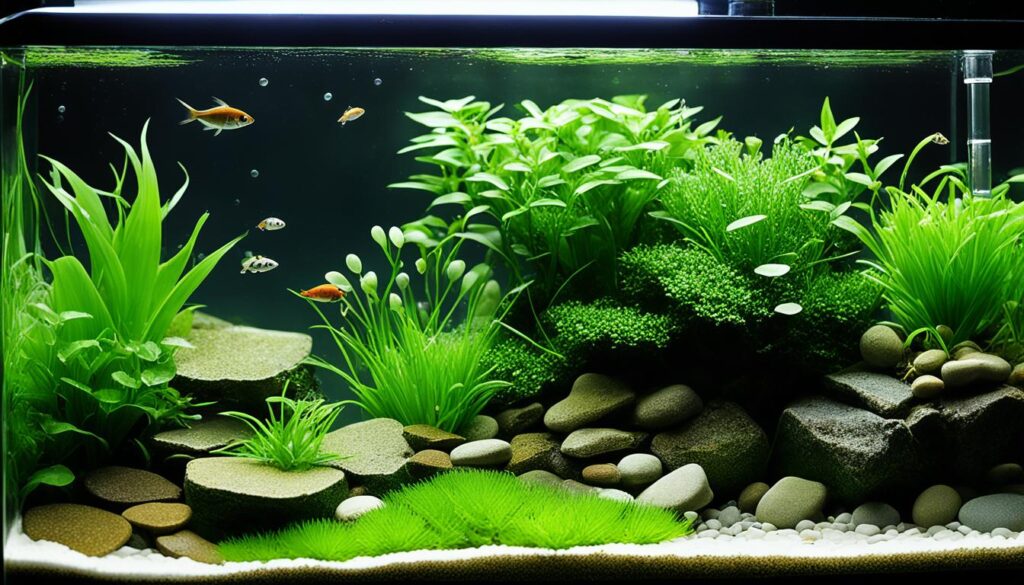
Setting up the Tank for Fishless Cycling
Before starting the fishless cycling process, it is important to properly set up all the components of your tank. These components play a crucial role in creating a conducive environment for nitrifying bacteria, which are essential for the nitrogen cycle.
Firstly, ensure that your filters, substrate, and any other equipment are installed correctly. Filters are responsible for removing debris and providing aeration, while a suitable substrate allows beneficial bacteria to thrive. By setting up these components properly, you create a stable foundation for the cycling process.
Additionally, checking and maintaining the pH of your tank’s water is crucial. The ideal pH range for fishless cycling is between 7.0 and 7.8. Maintaining the proper pH level ensures that the nitrifying bacteria can efficiently convert ammonia to nitrite and nitrite to nitrate, supporting a healthy nitrogen cycle.

Properly setting up your tank’s components and maintaining the water’s pH are essential steps in preparing for a successful fishless cycling process. These measures create an optimal environment for beneficial bacteria and promote a stable nitrogen cycle in your aquarium.
Steps for Fishless Cycling
If you prefer a humane and controlled method of cycling your aquarium, fishless cycling is the way to go. This process involves adding a source of ammonia, such as fish food, to the tank and monitoring the ammonia and nitrite levels. By following these steps, you can successfully initiate and progress through the fishless cycling process.
- Add a source of ammonia: Start by adding a small amount of fish food or pure ammonia to the tank. This will stimulate the growth of nitrifying bacteria, which are essential for the nitrogen cycle. Remember to follow the recommended dosage and avoid overfeeding the tank.
- Monitor ammonia levels: Regularly test the ammonia levels in the tank using a reliable aquarium test kit. Aim to maintain an ammonia concentration of around 2-4 ppm (parts per million). If the ammonia levels drop below 2 ppm, add more fish food or ammonia as needed.
- Monitor nitrite levels: As the beneficial bacteria establish themselves in the tank, they will convert ammonia into nitrite. Test the nitrite levels using an aquarium test kit. Initially, the nitrite levels will rise, indicating the presence of nitrite-producing bacteria.
- Adjust ammonia levels: As the bacteria continue to multiply and convert ammonia to nitrite, it is important to maintain a low but detectable level of ammonia. This ensures a constant food source for the bacteria. Adjust the ammonia levels as necessary, keeping them within the recommended range.
- Monitor nitrate levels: As the nitrite-producing bacteria become more established, they will convert nitrite into nitrate. Test the nitrate levels using an aquarium test kit. When nitrate levels start to rise, it indicates that the nitrogen cycle is progressing well.
Repeat these steps as necessary until the tank is fully cycled, indicated by declining ammonia and nitrite levels and a stable nitrate concentration. It is important to be patient during the fishless cycling process, as it can take several weeks for the cycle to complete.

Cycling an Aquarium with Fish
While fish-in cycling may be an option for some experienced aquarists, it comes with risks and requires certain precautions to protect the health of the fish.
Adding fish to an aquarium during the cycling process exposes them to high levels of ammonia and nitrite, which can be harmful. This method is not recommended for beginners who may not have the experience or knowledge to closely monitor water parameters and address any issues that arise.
If you choose to attempt fish-in cycling, it is essential to take the following precautions:
- Start with a small number of hardy fish species known for their resilience to water parameter fluctuations, such as danios or guppies.
- Regularly test the water parameters using an aquarium test kit to monitor ammonia, nitrite, and nitrate levels.
- Perform frequent partial water changes to keep the ammonia and nitrite levels as low as possible.
- Consider using a water conditioner that can neutralize ammonia and reduce its toxicity to the fish.
- Observe the behavior and health of the fish closely. If any signs of stress or illness are observed, take immediate action to address the issue.
Remember, fish-in cycling should only be attempted by experienced aquarists who are well-equipped to handle the risks involved and ensure the health and well-being of the fish throughout the process.
“Fish-in cycling can be challenging and potentially harmful to fish if not done correctly. It is important to prioritize the well-being of the fish and closely monitor water parameters to minimize stress and risks.”
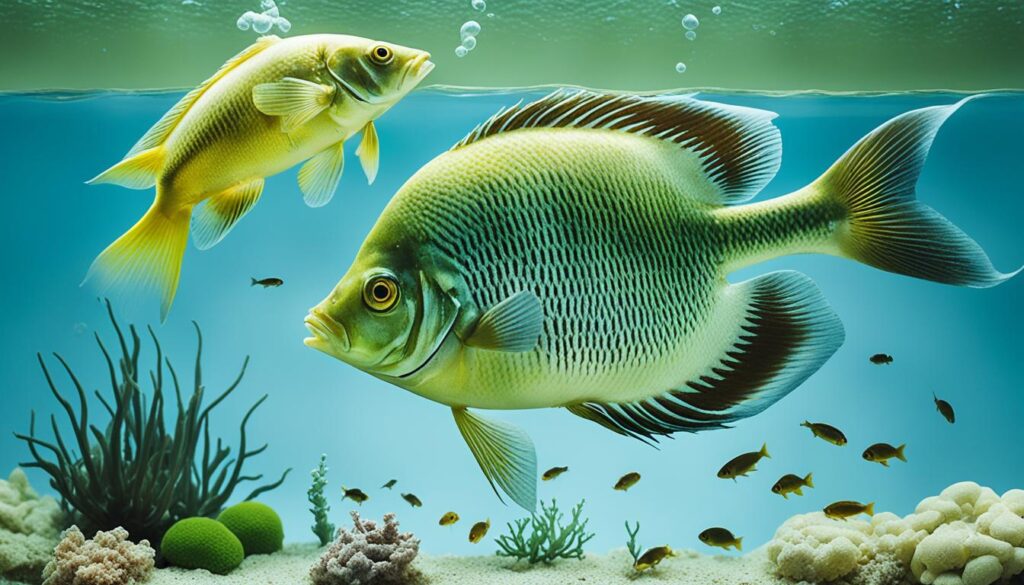
By following these precautions and closely monitoring the aquarium’s water parameters, you can mitigate some of the risks associated with fish-in cycling. However, it is essential to note that fishless cycling remains the recommended method for beginners and those looking to create a safe and stable environment for their fish.
Conclusion
Creating a healthy and stable environment for your fish is of utmost importance when setting up a new freshwater aquarium. Cycling your aquarium is a crucial step in achieving this goal. By following the step-by-step guide outlined in this article, you can successfully cycle your aquarium and ensure the well-being of your fish.
Regularly monitoring the water parameters, including ammonia, nitrite, and nitrate levels, is essential in maintaining a cycled aquarium. This allows you to detect any imbalances and take necessary actions to rectify them promptly. Providing a clean and well-maintained habitat for your fish not only improves their overall health but also enhances their longevity.
In conclusion, aquarium cycling is not only important but also necessary for the health and well-being of your fish. It creates a biologically safe environment by establishing a balanced nitrogen cycle in the aquarium. By taking the time to properly cycle your aquarium and maintaining it thereafter, you can enjoy the beauty of your fish in a thriving and healthy aquatic environment.
FAQ
What is aquarium cycling?
Aquarium cycling is the process of creating a biologically safe environment for fish in a new tank by introducing nitrifying bacteria to regulate the nitrogen cycle.
Why is aquarium cycling important?
Aquarium cycling is important because it prevents ammonia buildup, which can be harmful to fish. It creates a healthy and stable environment for the fish and prevents New Tank Syndrome.
How long does aquarium cycling take?
The duration of aquarium cycling can vary, but it generally takes between four to eight weeks. Factors such as tank size and water parameters can influence the cycling time.
What items do I need for aquarium cycling?
You will need fish food, an aquarium test kit, necessary aquarium components, and a quality water filter to ensure a successful cycle.
What is fishless cycling?
Fishless cycling is a method of cycling an aquarium without exposing fish to high ammonia levels. It involves adding a source of ammonia, such as fish food, to stimulate the nitrogen cycle.
How do I set up the tank for fishless cycling?
Properly set up all tank components, such as filters and substrate, and maintain the water’s pH in the ideal range of 7.0 to 7.8 to promote the efficient nitrogen cycle.
What are the steps for fishless cycling?
The steps for fishless cycling include adding a source of ammonia, monitoring ammonia and nitrite levels, and adjusting ammonia levels as needed to ensure the cycling process progresses properly.
What is fish-in cycling?
Fish-in cycling is a method that involves adding fish to the tank during the cycling process. It is not recommended for beginners due to the high ammonia and nitrite levels that can be harmful to fish.
What is the importance of a cycled aquarium?
A cycled aquarium provides a healthy and stable environment for fish, preventing ammonia and nitrite buildup. It ensures the well-being of fish and reduces the risk of New Tank Syndrome.
How do I maintain a healthy environment after cycling the aquarium?
Regularly monitor water parameters, perform water changes, and maintain proper filtration and feeding routines to ensure the continued health and well-being of your fish.

